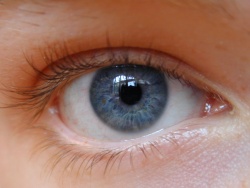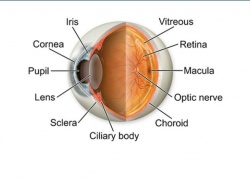Eye
The human eye is an organ which reacts to Light for several purposes. As a conscious sense organ, the mammalian eye allows vision. Rod and cone cells in the retina allow conscious Light Perception and vision including color differentiation and the Perception of depth. The human eye can distinguish about 10 million colors.
In common with the eyes of other mammals, the human eye's non-image-forming photosensitive ganglion cells in the retina receive the Light signals which affect adjustment of the size of the pupil, regulation and suppression of the hormone melatonin and entrainment of the Body clock'
General properties
The eye is not shaped like a perfect sphere, rather it is a fused two-piece unit. The smaller frontal unit, more curved, called the cornea is linked to the larger unit called the sclera. The corneal segment is typically about 8 mm (0.3 in) in radius. The sclerotic chamber constitutes the remaining five-sixths; its radius is typically about 12 mm. The cornea and sclera are connected by a ring called the limbus.
A child's eye showing distinct limbal ring.
The iris – the color of the eye – and its black center, the pupil, are seen instead of the cornea due to the cornea's transparency. To see inside the eye, an ophthalmoscope is needed, since Light is not reflected out. The fundus (area opposite the pupil) shows the characteristic pale optic disk (papilla), where vessels entering the eye pass across and optic nerve fibers depart the globe.
Dimensions
See also: mammalian eye
The dimensions differ among adults by only one or two millimeters. The vertical measure, generally less than the horizontal distance, is about 24 mm among adults, at birth about 16–17 millimeters (about 0.65 inch). The eyeball grows rapidly, increasing to 22.5–23 mm (approx. 0.89 in) by three years of age. By age 13, the eye attains its full size. The typical adult eye has an anterior to posterior diameter of 24 millimeters, a volume of six cubic centimeters (0.4 cu. in.), and a mass of 7.5 grams (weight of 0.25 oz.).
Components
The eye is made up of three coats, enclosing three transparent structures. The outermost layer is composed of the cornea and sclera. The middle layer consists of the choroid, ciliary Body, and iris. The innermost is the retina, which gets its circulation from the vessels of the choroid as well as the retinal vessels, which can be seen in an ophthalmoscope.
Within these coats are the aqueous humor, the vitreous Body, and the flexible lens. The aqueous humor is a clear fluid that is contained in two areas: the anterior chamber between the cornea and the iris, and the posterior chamber between the iris and the lens. The lens is suspended to the ciliary Body by the suspensory ligament (Zonule of Zinn), made up of fine transparent fibers. The vitreous Body is a clear jelly that is much larger than the aqueous humor, present behind lens and the rest, and is bordered by the sclera, zonule, and lens. They are connected via the pupil.
Blood vessels can be seen within the sclera.
Dynamic range
The retina has a static contrast ratio of around 100:1 (about 6.5 f-stops). As soon as the eye moves (saccades) it re-adjusts its exposure both chemically and geometrically by adjusting the iris which regulates the size of the pupil. Initial dark adaptation takes place in approximately four seconds of profound, uninterrupted darkness; full adaptation through adjustments in retinal chemistry (the Purkinje effect) is mostly complete in thirty minutes. Hence, a dynamic contrast ratio of about 1,000,000:1 (about 20 f-stops) is possible. The process is nonlinear and multifaceted, so an interruption by Light merely starts the adaptation process over again. Full adaptation is dependent on good blood flow; thus dark adaptation may be hampered by poor circulation, and vasoconstrictors like tobacco.
The eye includes a lens not dissimilar to lenses found in optical instruments such as cameras and the same principles can be applied. The pupil of the human eye is its aperture; the iris is the diaphragm that serves as the aperture stop. Refraction in the cornea causes the effective aperture (the entrance pupil) to differ slightly from the physical pupil diameter. The entrance pupil is typically about 4 mm in diameter, although it can range from 2 mm (f/8.3) in a brightly lit place to 8 mm (f/2.1) in the dark. The latter value decreases slowly with age; older people's eyes sometimes dilate to not more than 5-6mm.
Field of view
The approximate field of view of an individual human eye is 95° away from the nose, 75° downward, 60° toward the nose, and 60° upward, allowing humans to have an almost 180-degree forward-facing horizontal field of view. With eyeball rotation of about 90° (head rotation excluded, peripheral vision included), horizontal field of view is as high as 270°. About 12–15° temporal and 1.5° below the horizontal is the optic nerve or blind spot which is roughly 7.5° high and 5.5° wide

